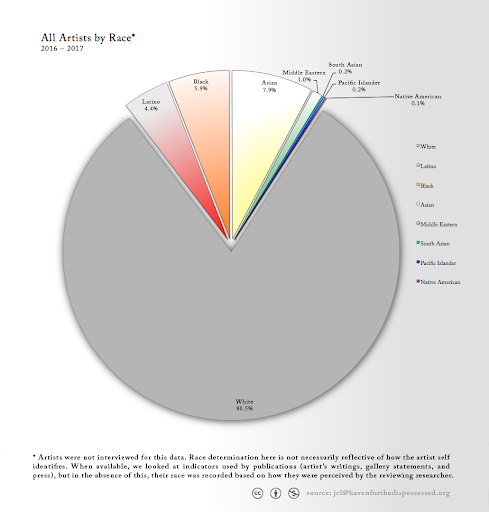The art world has a lot of cultural catching up to do in many areas.
Increasingly growing public support for diversity and inclusion is making art—and everything else—more vibrant. Like many other parts of our society and economy, the art world has a lot of cultural catching up to do.
Art, in theory, is for everyone. Art is supposed to unite people. So, for the masses of different types of people to connect through art, the business of art must empower artists and artwork that resonates with a diversity of audiences.
What Is Inclusion and Equity In the Arts?
Many in the art world believe that inclusion and equity begins with providing a full range of demographics access to opportunities and spaces traditionally relegated to homogenous art institutions.
The idea of diversity and inclusion in the arts purports that an equal society depends on the adequate representation of artistic people of every background.
Art inclusion requires a universal cultural consciousness regarding race/ethnicity, age, disability, sexual orientation, gender, socioeconomic status, and religion. Art organizations, therefore, must implement leadership, learning, services, and transparent policies that deconstruct inequality to elevate diverse creative perspectives.
The Struggle of Diversity and Inclusion In Art Galleries and Museums
Underrepresentation
A recent study shows that of all the art in the top New York art galleries, 80% is by white artists, and 70% is by male artists.
Women artists create 30% of pieces in top New York galleries, but make up less than 15% of the works included in all museum acquisitions and exhibitions—despite women accounting for up to two-thirds of art undergraduates. Showing ethnically diverse art and LGBTQIA art in galleries and museums is even rarer.
Insufficient Change
Lack of Demand
Galleries present the art they believe collectors want and value. Their myopic perception of collector demand, however, can support a disproportionate demand for pieces by culturally homogenous artists. Unsurprisingly, art buyers and collectors with minimum exposure to a broader spectrum of artists will confine their purchases to pieces from artists of limited demographics.
Why Diversity and Equity In the Arts Is Important
Deliberate and responsible art inclusion and equity could change the face of art galleries, museums, and auctions for the better.
Cultural Relevance
The urgent need for diversity and equity in the arts will only grow moving forward. The arts continue to be at risk of alienating underrepresented communities, even though now more than half of Americans under five years old are minorities. The time is now to inspire younger generations by showing them art and artists they can relate to and celebrate.
Organizational Progress
Generating Collector Demand
Deliberate and responsible art inclusion and equity could change the face of art galleries, museums, and auctions for the better.
Instituting inclusivity-focused leadership, education programs, and policies in museums and galleries is of critical importance to the future of the art business. Meaningful diversity and equity reform could potentially reshape the appeal of typically underappreciated artists. Meaningful changes open up more possibilities for diverse artists to participate and prosper in the art world—and help art institutions appreciate the multifaceted sensibility of a new generation of art lovers.




